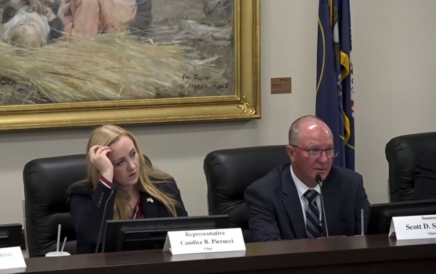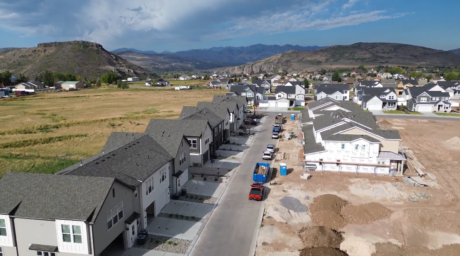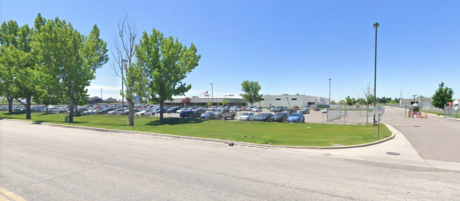Utah lawmakers consider slate of new congressional maps ‘under protest’
In the first public hearing for court-ordered redistricting, Utahns urge legislators to follow the ‘intent’ of Prop 4 as lawmakers also weigh a bill to limit new maps to ‘partisan bias test’

Screenshot from Utah Legislature website
Rep. Candice Pierucci, R-Herriman, left, and Sen. Scott Sandall, R-Tremonton, are pictured as co-chairs of the Legislative Redistricting Committee on Sept. 22, 2025. (Screenshot from Utah Legislature website)Utah’s court-ordered redistricting process underway this week is already heating up, with Democrats and some concerned Utahns frustrated that legislators still aren’t following the spirit of a voter-approved law that created an independent redistricting process.
The Utah Legislature’s newly convened Legislative Redistricting Committee held its first public hearing on Monday to consider a slate of five proposed congressional maps to choose from to submit to 3rd District Judge Dianna Gibson by their deadline of Oct. 6.
Gibson will ultimately decide by Nov. 10 which new map — whether it’s drawn by lawmakers or the plaintiffs in the redistricting lawsuit — will replace the 2021 boundaries that she voided in a ruling last month, deeming them a byproduct of an unconstitutional process.
All of the maps being considered would be relatively more competitive for Democrats when compared to the 2021 map that’s since been tossed out by the courts, but most of them would continue to mix rural and urban communities. Two, however, would take more of a “doughnut hole” approach and carve districts concentrated around the state’s urban core in and around Salt Lake City.
The Legislative Redistricting Committee did not take action on any map — not expected to publish its preferred choice until Thursday, ahead of a special session expected on Oct. 6 for the full Legislature to take a vote on the map. The committee is scheduled to meet again Wednesday at 11 a.m. to continue weighing next steps.
One of the committee’s co-chairs, Sen. Scott Sandall, R-Tremonton, emphasized in the first minutes of Monday’s hearing that lawmakers were meeting mid-decade due to court orders — “under protest” because the Legislature’s Republican supermajority disagreed with the judge’s ruling tossing out the 2021 map.
“We want to make sure that you understand that we are doing this in compliance with the court orders, and under protest,” Sandall said. “But we want to make sure we maintain our constitutional duty to produce a map, so we are going to proceed in that direction.”
Several Utahns who spoke during the meeting’s public comment period bristled at Sandall’s “under protest” comment.
“Prop 4 is the will of the people. … This is what we want. We want good faith representation and a good faith effort,” said Magdeleine Bradford-Butcher, of Provo. “We are here to do something that is fair for all citizens. Nobody should be protesting that.”
New changes to Proposition 4
In addition to reviewing those proposed maps, lawmakers also weighed a bill that would again impose changes to Better Boundaries’ 2018 voter-approved ballot initiative known as Proposition 4 that sought to create an independent redistricting commission.
The courts have since determined that Proposition 4, as passed by a slim majority in 2018, is now law. But a draft bill, proposed by Sen. Brady Brammer, R-Pleasant Grove, would add a new requirement into Proposition 4’s redistricting criteria that would specify that future maps would need to pass a specific statistical “partisan bias test” that ensures “partisan symmetry.”
Proposition 4’s language already says maps “may not divide districts in a manner that purposefully or unduly favors or disfavors any incumbent elected official, candidate or prospective candidate for elective office or any party.” It also already requires the Legislature and the Independent Redistricting Commission to use “the best available data and scientific and statistical methods, including measures of partisan symmetry” when drawing maps that conform to Proposition 4’s criteria.
Brammer’s bill would specify, however, that a map that is “symmetrical under the partisan bias test” would not “unduly favor or disfavor.” And it would require any judge’s review of a new congressional map, including Gibson’s, to use the “partisan bias test” as the only tool to determine a map’s fairness.
The “partisan bias test” defined in Brammer’s bill would use the average margin of past statewide elections (for president, governor, attorney general, treasurer and auditor) to calculate a formula for “partisan symmetry.” A map would pass the test as long as the same statewide vote percentage would translate to the same percentage of seats for either party. The test, would set an acceptable margin based on the average of past statewide elections, which typically have a wide spread between GOP and Democratic voters — with Republicans consistently winning by more than 20 points in statewide races.
Critics, however, including Democrats on the Legislative Redistricting Committee, argued that requiring the “partisan bias test” as defined in Brammer’s bill would be problematic for a state like Utah that has only four congressional districts and is dominated statewide by the sheer number of registered Republicans compared to Democrats.
“You’re now trying to codify partisan bias as the only test you use, and that to me is a gigantic red flag,” Senate Minority Leader Luz Escamilla, D-Salt Lake City, said. “We should have more tests and have them all run in a blind way … so we’re defeating the entire purpose of (Prop 4’s) intent.”
Rep. Doug Owens, D-Millcreek, argued Brammer’s bill shouldn’t be lawmakers’ first move after the court ordered the Legislature to comply with Proposition 4.
“Are you concerned about the optics of that?” Owens asked Brammer during Monday’s hearing. “The court says follow Prop 4 and the first thing out of the chute is we’re narrowing Prop 4?”
Brammer said he’s not concerned about that, because he’s looking to clarify the law to define a “workable” legal test. While making the case for his bill, Brammer pointed to a sentence in Gibson’s August ruling that specified “the legislature retains discretion in determining” what tools should be used when evaluating maps. He said that was an “invitation” from the courts to lawmakers to define the parameters.
“The fact that we exercise discretion does not mean that you’re undermining a bill,” Brammer said. “What it means is that you’re actually trying to create a workable methodology for parties to use when proposing maps. And so that’s what we’re working towards.”
Owens, however, argued that Brammer’s bill sets a rigid definition of “partisan symmetry” that not all experts would agree on.
“Are you aware that in the academic literature there is more than one definition of partisan symmetry?” Owens challenged.
Brammer said Proposition 4 “could have very easily defined partisan symmetry” and stated “which tests they were going to use.” He indicated he would be open to debating having more than one method, but he resisted “keeping it wide open and undefined and subject to everyone arguing.”
“This is simply so that we don’t have a food fight between experts as to the statistical analysis of partisan symmetry,” Brammer said.
Owens continued to push back.
“I think the committee deserves to know that this is a hotly debated issue in the academic literature and in the courts,” Owens said.
He argued “there is no real world scenario” where the minority party in Utah (Democrats) would win using a map approved under the partisan bias test.
“This has been specifically criticized as a valid measure of gerrymandering when it’s applied in a lopsided state,” Owens said. “In the real world, the dominant party is going to win every one of those four seats.”
The Utah Legislature’s redistricting expert
The author of the proposed maps being considered by the Legislative Redistricting Commission is Sean Trende, a senior elections analyst for RealClearPolitics and a nonresident fellow at the American Enterprise Institute.
Trende, whom legislative leaders had also retained as an expert witness in the state’s redistricting litigation, was separately contracted with the Office of Legislative Research and General Counsel to conduct map analysis submitted by legislators, according to legislative researchers who spoke during Monday’s hearing.
Trende has been retained as an expert witness in dozens of redistricting cases across the country. He was appointed by the Supreme Court of Virginia as one of the co-masters that drew Virginia’s maps after the state’s redistricting commission deadlocked.
Trende testified during Monday’s hearing on a remote call, from Delaware, Ohio. He walked through all of the proposed maps, explaining that they were drawn using his computer models and the “partisan bias test” while ensuring they factor in Proposition 4’s requirements and evenly distribute populations as constitutionally required.
Because Salt Lake County’s population would be too big to form a single district, it has to be split at least once.
Trende said two of the maps being considered were “simulation maps” made to conform to equal population requirements, while two others were “based on” the 2021 congressional map, but “made to bring it into conformance” with Proposition 4’s requirements.
“So I did draw them, in a way, but not with a free hand,” Trende said.
When Owens asked whether he always testifies in favor for one party in redistricting cases, Trende pushed back, saying he helped a Democratic caucus in Michigan to come up with a remedial map, and “there are times where I tell Republicans, ‘I’m sorry, I can’t say your map’s not a gerrymander.'”
When Owens pressed on Brammer’s proposed “partisan bias test” requirement, Trende said he’s never seen a state specifically require partisan symmetry as a standard in an independent redistricting process, “but by doing it, I think one of the consequences is that partisan bias is a test that has to be considered.”
“The only test that really tests partisan symmetry is partisan bias,” Trende said. “In my view, it’s not an option, since (Prop 4) specifically says to include tests (for) partisan symmetry. I don’t think there’s an option to not include a partisan bias test.”
When the committee’s co-chair Sen. Scott Sandall, R-Tremonton, asked Trende whether any of the 2021 maps that were proposed — including those recommended by the independent redistricting commission at the time — would be fair under Proposition 4’s standards today, Trende said they likely wouldn’t.
“I think they would all have problems,” he said.
While the 2021 congressional map that lawmakers enacted split Salt Lake County four ways, Trende said all of the independent redistricting commission maps would “fail the partisan bias test.”
“They show indications of maps being drawn with partisan intent,” he said. “So I don’t think any of those maps are live options under Prop 4.”
When Owens pressed Trende on whether his computer models’ partisan symmetry tests “allow a district that had a Democrat majority,” Trende said “probably.”
Owens, however, expressed skepticism.
“So it’s baked in the cake if we adopt this test that there will never be, and cannot be, and it’s impossible to have, a Democratic majority district,” Owens said. He challenged Trende to produce a map “that shows a Democratic majority and applies his symmetry test, just to see if it’s possible, because I don’t think it is.”
Utahns urge lawmakers to preserve ‘intent’ of Proposition 4
More than a dozen Utahns — both in person and remotely — spoke during Monday’s public hearing, urging lawmakers to adhere to Proposition 4’s intent while also expressing concern that Brammer’s bill, and the proposed maps under consideration, don’t bode well.
Tiffany Smith, a retired attorney who lives in Millcreek, said she’s a registered Republican who comes from “a long line of family who have served on both sides of the aisle” in both legislative and judicial roles.
“As a lawyer, I want to commend you for trying to convince anyone watching today that the partisan bias test is the only test that is the best test. Wow. You did a great job,” she said. “However, those arguments are not germane to the complete language of Proposition 4. And they distract from the intent in the language of the law.”
Smith countered that lawmakers are tasked with adhering to Proposition 4, “the neutral criteria and the ban on partisan gerrymandering.”
“Please respect the will of the voters and not ignore us,” she said. “We are ‘we the people.’ You are accountable to us. Please keep communities together, and if that means that we have an independent or Democratic (representative) … wouldn’t it be refreshing to be the state that actually represents its people fully and set an example of representative democracy?”
She also emphasized that Proposition 4 encouraged the redistricting process to use statistical methods — plural — and not just one test.
“Cherry picking a test reverse engineered to say that partisan gerrymandering is fair is improper and undermines the purpose of Proposition 4,” she said.
Utah News Dispatch is part of States Newsroom, the nation’s largest state-focused nonprofit news organization.



